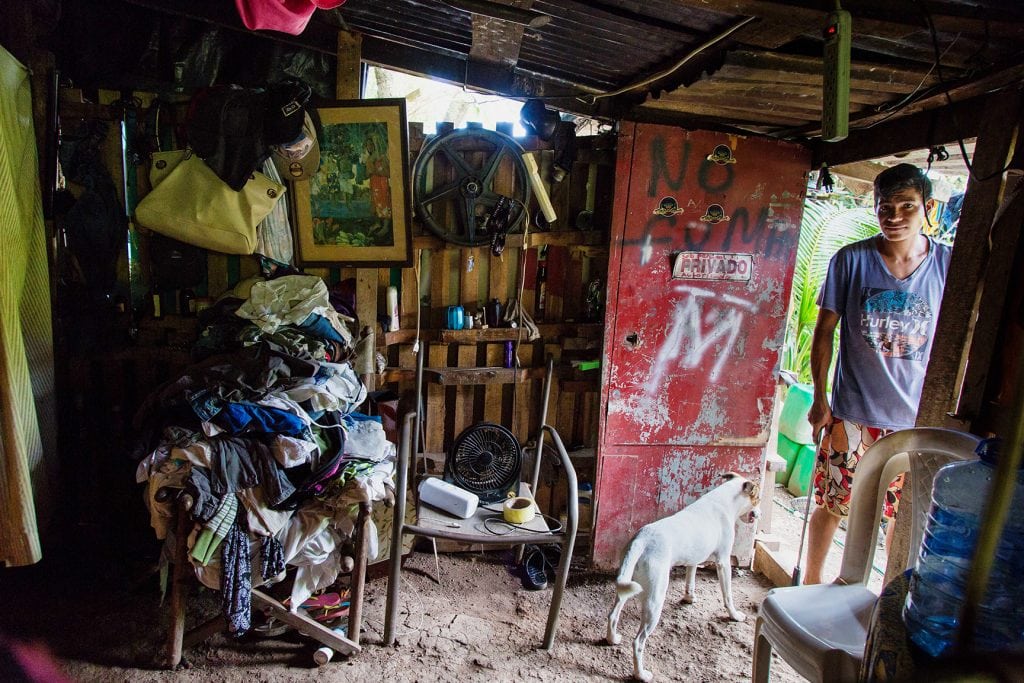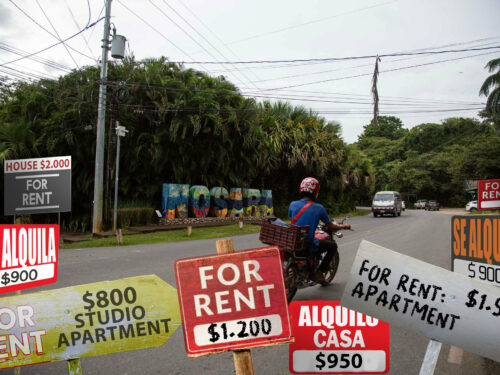
Uziel Sánchez walks over the heaps of trash in the Nosara dump with a machete in his hand.
“At the start, I couldn’t stand the smell and I would have to go and vomit,” he says. He’s 22 years old and came to live in the dump three years ago with his mom and stepdad.
There’s so much trash here that it’s about to spill out into the streets.
“A guy who has been here a lot longer than I have told me to think about something else, that I should imagine that I’m in a nicer place. That’s how I stopped getting sick,” Uziel says.
A clothes iron sticks out of the pile. Uziel bends over, whacks it with his machete and pulls out a handful of copper and aluminum, as if it were intestines, that he will sell to the owner of the dump later. This is how days here go for Uziel and 13 other people who live in the eight houses built and furnished with what they are able to find in the dump. No one has potable water and electricity comes through a chord strung from the recycling center.

Uziel quit school after second grade in order to help work. Before working in the dump, he worked in construction.Photo: César Arroyo
The situation at the Nosara dump, no matter where you look, is critical. Ever since the environmental court ordered its closure in 2013, Nicoya City Hall has promised that it will solve the problem of trash collection in the town and will take waste to Santa Cruz, like other districts in the canton.
But the community has been fighting for this service for years. In the past year, the local government has committed several times to open bidding for the garbage route, but it still doesn’t seem to be a tangible reality. According to the city’s environmental department, trash collection will start in October, without delay.
Nosarans aren’t losing hope, but they also don’t believe the local government’s word. “See it to believe it” is their most common saying.

There are eight houses within the limits of the Nosara trash dump where 14 people live.Photo: César Arroyo
The community has found ways to deal with the problem. Nosara Recycles is one of those initiatives. The nonprofit organization collects and separates recyclable material in order to sell it and also gives talks at schools and organizes beach cleaning trips.
Cristian Zumbado, the organization’s manager, thinks that taking the trash somewhere else isn’t enough. For him, the comprehensive solution is creating a type of “transfer station” where recyclers can separate recyclable material from trash in a cleaner and safer space and send non-recyclable material to the Santa Cruz dump.

Mayra Rosales (66) lives in La Esperanza and travels everyday to the dump in the first bus. Before starting work, she sits down and eats gallo pinto.Photo: César Arroyo
More than Tenders and Trash Broth
Seen from above, the dump looks like a large carcinogenic mole that expands through the Nosara forest. While nature has tried to recover some of the land, covering some zones in grass, everytime the dump fills up, those who live in there use a tractor to spread the trash around. Every time they do this, they get closer to the streams that surround the land.
The streams are seasonal and fill up during the rainy season and dry out during the summer. Today, they are full and Uziel and his friend Luisfer, another recycler, go fishing for river shrimp at night. They aren’t easy to catch and even less so when they are hidden beneath roots covered with plastic bags and trash.
When they can’t catch what they hoped, they blame the poison in the water for killing their prey.

The bakery in Liberia where Aldin Hernández (17) used to work closed after a robbery. Since then, he has been working in the trash dump.Photo: César Arroyo
The trash produces a liquid called lixiviate that seeps into the earth and pollutes aquifers. This has worried the community for years. In fact, in a 2016 study done by Nosara Recycles confirmed that the well below the dump has fecal coliforms. Recyclers continue to extract water from it, but they don’t drink it.
The lack of recognition in public policy about the work recyclers do keeps them in the informal sector with few or no social guarantees. But, thanks to their work, between 50 and 90 percent of recyclable material in Latin America is recovered, according to data from the Regional Inclusive Recycling Initiative (IRR), a public-private platform present in 15 countries, including Costa Rica. In Latin America, there are four million people working in this trade.

Mayra Rosales moves material in her sector in order to recycle it. She works from Monday through Sunday in the dump. In a good month, a recycler can make a little more than ¢200,000 ($350)Photo: César Arroyo
Zumbado says that all the changes that Nosara makes to control the problem must also consider solving the needs of recyclers, creating better conditions for them. This won’t only improve their quality of life, but will also increase their productivity.
While Nosara has a community of people from several different countries that gives it an image of strong ecological awareness, Zumbado says that it isn’t the paradise that everyone imagines and that private companies should be more committed to solving the problem so that, above all, young kids like Uziel and Luisfer have a brighter future.







Comments